Posts Tagged ‘anti-Semitism’
Sunday, December 28th, 2014
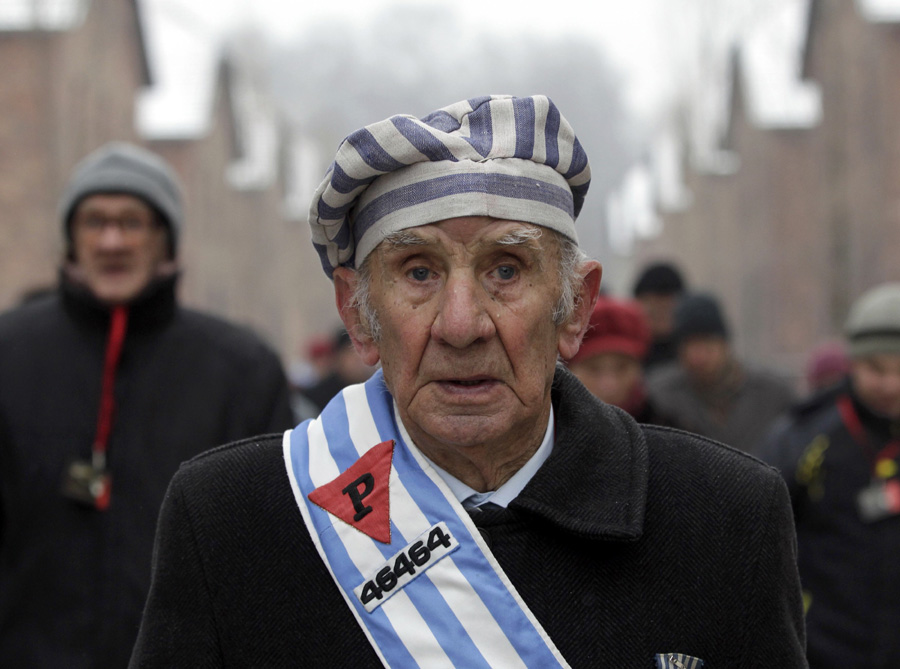
Have we had enough of this theater yet? Do “holocaust” images like this have any effect on our sympathies? This is a well-aged, healthy looking “survivor” at the 69th Anniversary of the Auschwitz liberation on Remembrance Day, Jan. 27, 2014
___________________________________________________________
By Carolyn Yeager
Wiesel: “I thought the memory of the Holocaust would shame those boasting anti-Semitic opinions. I was wrong.” … Jan. 28, 2014
It becomes more clear all the time that the massive goodwill that Jews and “Israel” gained from the propaganda hoax they named “The Holocaust” has been depleted, due in large measure to Israel’s uncivilized aggressive behavior against its neighbors in the Middle East.
But another major reason for the loss of goodwill is Israel’s and world Jewish organizations’ insatiable lust for ever more money and arms from Germany, the U.S. and all of Europe and North America. The Jews have played the phony guilt card for all it’s worth, and for a long time now (70 years!) – and it is finally wearing out. When Jews tell us that grandchildren of “survivors” are carriers of their grandparents’ “trauma,” that becomes the straw that breaks the camel’s back.
Both Elie Wiesel and Caroline Glick have made statements in 2014 referring to the “Holocaust” as a way – a vehicle – to do away with “antisemitism,” i.e. dislike of Jews. They thought the combination of the horrific atrocity stories camp survivors were able to dream up, and the incredible number of 6 million, plus having the governments of America, Britain and the Soviet Union on their side would keep Germans and all European people making amends to them for a good long time – long enough, anyway, for Jewish billionaires to completely consolidate their ownership/control of everything of value in the Western world (just as it’s told in The Protocols of the Learned Elders of Zion).
But as it turns out, European men and women are more resilient than that. And then Jews, in their chutzpah, make plenty of mistakes, too. The end result, as we enter the year 2015, is that Jews, rather than feeling victorious, are crying and gnashing their teeth over “the rise of antisemitism in Europe.”
Is there a conspiracy going on?
Today, I went looking for what I remembered as Elie complaining about antisemitism in the same way that Caroline Glick does. I quickly came upon it, and it was from January 28, 2014, the exact same day that Glick’s blog post appeared! … the one I wrote about here. Coincidence?
They are both saying the same thing, each in their own way, on the day after the “International Holocaust Remembrance Day” on Jan. 27, which was not such a big success. The major news story it conjured up was that the Israeli Knesset sent a large delegation that marched around on Auschwitz memorial grounds with giant blue and white flags, while having their picture taken. Elie Wiesel did not show up, which took away some of the news-worthy luster of the 2014 event.
It’s interesting that Benjy Netanyahu was saying pretty much the same as Glick and Wiesel just recently:
“We saw today examples […] of European prejudice. In Geneva, they are calling for an investigation against Israel for war crimes, while in Luxembourg the European court removed Hamas from the terrorist list. It looks like there are too many people in Europe, on the [same] ground where six million Jews were slaughtered, who haven’t learned a thing. The friendship we see from the United States stands in complete contrast to what we are seeing regretfully in Europe.”
Recall that Caroline Glick once worked as an assistant to Netanyahu. She and Elie Wiesel are both long-time Israeli assets, so do they coordinate their message?
What exactly did Wiesel say in this interview of eleven months ago?
“The Holocaust is a unique event, but it has a universal significance which must be memorized incessantly.”
“Unfortunately, anti-Semitism still exists. It has been alive for more than 2,000 years, and will likely continue living. I thought that the memory of the Holocaust would shame those boasting anti-Semitic opinions. I was wrong. It still exists in different countries, and it seems people are no longer ashamed to be anti-Semitic.”
“The modern anti-Semite is, first and foremost, anti-Israel. It’s very difficult to separate between the two.” (Anti-Israelism and antisemitism)
“There are anti-Semites who are only anti-Israel. Once I thought that anti-Semitism had ended; today it is clear to me that it will probably never end. It might weaken sometimes, but it will continue existing, because in different countries there is no shame in being an anti-Semite. We must remember that anti-Semitism led to Auschwitz. Without anti-Semitism there would have been no Auschwitz.”
“It’s clear to me that one can’t be Jewish without Israel. Religious or non-religious, Zionist or non-Zionist, Ashkenazi or Sephardic — all these will not exist without Israel. The [Israeli] State’s existence is the oxygen of the image and ideas of the new anti-Semitism.“
“Recent attacks on Jews in the United States are expressions of anti-Semitism, yet we can’t talk about an anti-Semitic movement but about groups of anti-Semites which operate in different places, and we don’t know how many members they have. This reality must also concern us, because it could expand.”
The difference between Wiesel and Glick is that he did not say the Jan. 27th International Holocaust Remembrance Day made antisemitism worse, not better, but he DID rather dismiss it by saying that in the United States it is only marked with an event held at the UN building.
He agrees with Glick that the real American commemoration is on Yom haShoah, the same day as for the State of Israel. According to Yoel Rappel, the Israeli whom Wiesel appointed to be the director of his archive at Boston University, it was Wiesel who proposed this day to the American Congress when he was chairman of the President’s Commission on the Holocaust under President Carter. It has become a “fixed tradition” in the U.S., said Rappel. ~
4 Comments
Category Featured | Tags: Tags: anti-Semitism, Caroline Glick, Holocaust fraud, Holocaust Remembrance Day, Israel,
Social Networks: Facebook, Twitter, Google Bookmarks, del.icio.us, StumbleUpon, Digg, Reddit, Posterous.
Sunday, February 2nd, 2014
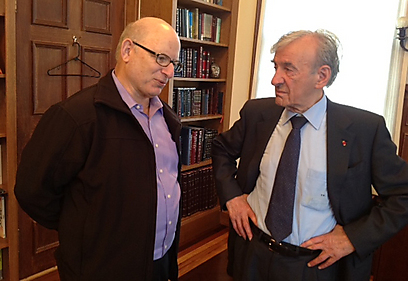
Elie Wiesel, right, in his office at Boston University with his Israeli editor, Yoel Rappel, whose interview with the famous survivor was published on January 28th in Israel’s Y-Net News.
By Carolyn Yeager
“Personal reasons” has been given for Elie Wiesel’s failure to attend this year’s annual International Day of Commemoration in Memory of Victims of the Holocaust at Auschwitz-Birkenau January 27th. This United Nations-declared commemoration day (since 2006) is being incorrectly called “Holocaust Memorial Day” or “Holocaust Remembrance Day” by the media and others who don’t feel like repeating the long, actual title.
The latter can become a problem because, as Wiesel’s interviewer pointed out in what follows : “The American nation officially commemorates the memory of the victims of the Holocaust on the same day as the State of Israel” — that is, on Yom Hashoah according to the Hebrew calendar, which falls in the Spring (April or May). This event is called “Days of Remembrance” and lasts for 7 days, beginning on Saturday evening Shabbat and ending at Shabbat one week later. In this, like in so much else, the U.S. is in lock-step with Israel (with Israel leading, the United States Congress following).
However, both the U.S. and Israel also support and join in with the newer January 27th United Nations-proclaimed commemoration, since it was conceived and pushed through the UN by the State of Israel. See here at bottom of page. That gives the world two major “Holocaust remembrance” events, all the better to “engrave” the holocaust into the minds of all humanity, but especially Western man.
The Interviewer
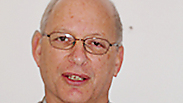 Yoel Rappel grew up in Israel and lived most of his life there. We’re not told if he was born there, but it seems so. He worked 40 years as a journalist and senior program editor at the Israel Broadcasting Authority, Israel’s main radio channel. Before coming to Boston University as Visiting Scholar at the Elie Wiesel Center for Jewish Studies, he also taught at Bet Berl College, the Avshalom Institute for Israel Studies, and served as content manager at the Center for Jewish Identity in Bar Ilan University … all in Israel.
Yoel Rappel grew up in Israel and lived most of his life there. We’re not told if he was born there, but it seems so. He worked 40 years as a journalist and senior program editor at the Israel Broadcasting Authority, Israel’s main radio channel. Before coming to Boston University as Visiting Scholar at the Elie Wiesel Center for Jewish Studies, he also taught at Bet Berl College, the Avshalom Institute for Israel Studies, and served as content manager at the Center for Jewish Identity in Bar Ilan University … all in Israel.
He serves as project manager for the Elie Wiesel Archive. He is the editor of the Hebrew editions of Prof. Wiesel’s books “The Biblical Soul,” “The Hasidic Soul” and “The Talmudic Soul,” which were published in Hebrew by the Yedioth Books publishing house. [Getting everything ready for Elie Wiesel’s coming sainthood -cy]
The Interview
[Rappel points out that it was Wiesel who coined the expression, “Not all victims were Jews, but all Jews were victims.” ]
Wiesel: “The Holocaust is a unique event, but it has a universal significance which must be memorized incessantly.”
[The reason for this, Rappel tells us, is so it will be engraved in people’s minds, so that the events of 1939-1945 will not repeat themselves and the world will not be indifferent and silent*, as it was then.] *A reference to the Yiddish book, “And the World Remained Silent” claimed to have been written by Wiesel.
Wiesel: “Unfortunately, anti-Semitism still exists. It has been alive for more than 2,000 years, and will likely continue living. I thought that the memory of the Holocaust would shame those boasting anti-Semitic opinions. I was wrong. It still exists in different countries, and it seems people are no longer ashamed to be anti-Semitic.”
[Rappel says “the murky wave of anti-Semitism sweeping over the Western world, as well as Eastern Europe (with the recent incidents in Hungary and Ukraine), is fresh.]
Wiesel: “The modern anti-Semite is, first and foremost, anti-Israel. It’s very difficult to separate between the two. There are anti-Semites who are only anti-Israel. Once I thought that anti-Semitism had ended; today it is clear to me that it will probably never end. It might weaken sometimes, but it will continue existing, because in different countries there is no shame in being an anti-Semite. We must remember that anti-Semitism led to Auschwitz. Without anti-Semitism there would have been no Auschwitz.”
[Rappel says that Wiesel is one of the State of Israel’s greatest advocates, and that Wiesel argues that the fundamental problem {today?} is the attitude towards Israel and not anti-Semitism.]
Wiesel: “It’s clear to me that one can’t be Jewish without Israel*. Religious or non-religious, Zionist or non-Zionist, Ashkenazi or Sephardic – all these will not exist without Israel. The State’s existence is the oxygen of the image and ideas of the new anti-Semitism.” *Dangerous, fanatical talk. It follows that if Israel goes, so also do Jews. With that thinking, anything is allowed to Jews to prevent it … is what Wiesel is getting at. The failure of Israel would be another form of “extermination of the Jews,” another “holocaust.” -cy
[Wiesel is asked whether the public dispute over circumcision and ritual animal slaughter also stem from anti-Semitism.]
Wiesel: “In my opinion, it stems first of all from ignorance and disregard of the Jewish faith. Those who raise such ideas and others will soon come up with the idea to cancel Shabbat, so that Jews will rest on Sunday. It’s more of a case of ignorance, and it leads to harassment against the foundations of Judaism.”
[Rappel wants to know if the different phenomena experienced recently by the Jewish community in the United States can be defined as anti-Semitism.]
Wiesel: “There are expressions of anti-Semitism, yet we can’t talk about an anti-Semitic movement but about groups of anti-Semites which operate in different places, and we don’t know how many members they have. This reality must also concern us, because it could expand.”
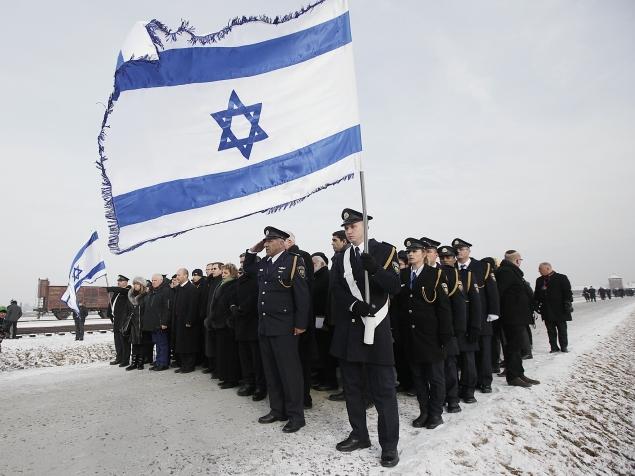
What Wiesel Missed – Members of Israeli parliament, the Knesset, ceremoniously and ostentatiously mark the 69th anniversary of the liberation of Auschwitz in Oswiecim, Poland on Jan. 27, 2014. The delegation spokesman made it a point to say that the difference between then and now is that they now have a state and a military force of their own with which to protect themselves.
2 Comments
Category Featured | Tags: Tags: anti-Semite, anti-Semitism, Auschwitz-Birkenau, Boston University, Holocaust remembrance, Israel, Joel Rappel, shabbat, Yom Hashoah,
Social Networks: Facebook, Twitter, Google Bookmarks, del.icio.us, StumbleUpon, Digg, Reddit, Posterous.
Sunday, September 8th, 2013
By Carolyn Yeager

Above: Ken Waltzer’s now notorious signature photo connecting him to his claim, for years, that Elie Wiesel was in this photograph of youths from the Buchenwald children’s barracks being marched out of the camp after so-called liberation.
We have further proof that Elie Wiesel was not at Buchenwald because Prof. Ken Waltzer is still unwilling to publish his book about the “rescue of children from Buchenwald,” a book which has always included the “Nobel Laureate Elie Wiesel”among the children.
Since Waltzer is the only holocaust “historian” I know who is still on record as saying he can prove that Elie Wiesel was a prisoner at the Buchenwald concentration camp—and that his father Shlomo died there—I think that makes Waltzer a fitting subject for this website. And the 84-year old Wiesel himself is not doing anything that I can find news of these days, so I’m a little hard up for inspiration.
Thus I ask: What is Waltzer up to? Well, he has been heading a group of Michigan Jews in creating a traveling exhibition that is meant to remind Jews, and convince if necessary, of all the poisecution they experienced during the WWII years and to celebrate how extraordinarily well things have been going for Jews since (while, of course, still having to be on guard against new poisecution).
Thus, the exhibition is titled Uneasy Years: Michigan Jewry During Depression and War. Michigan Jewry! How many Jews are in Michigan? According to a Jewish website, in 2012 there were 82,270, which is 0.8% (8/10 of 1%) of the total Michigan population. But that is enough for Ken Waltzer and other Jews to build an entire traveling exhibition for.
Or could the reason really be that Waltzer, as a professor at Michigan State University, must always show that he is active and contributing scholastically in his area of expertise. Since his book on the “rescue of children at Buchenwald” continues to be in a state of “research”—after all these years—he must find other projects to work on. 1 Last year he was consultant on a Jewish film project about holocaust survivors. This year he’s got the traveling exhibition.
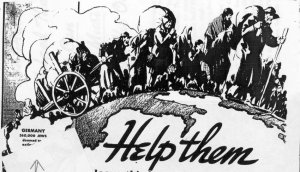 What is learned from the exhibition
What is learned from the exhibition
The 21st Century Jews of Michigan are told that in past times they had to join together to help needy fellow Jews. The message is conveyed that they still need to do so because Jews are always in need, as “anti-Semitism” is always a threat—somewhere. Hasn’t it always been so? Elie Wiesel would approve of this message! [Right: Theme image for the Allied Jewish Campaign, 1938]
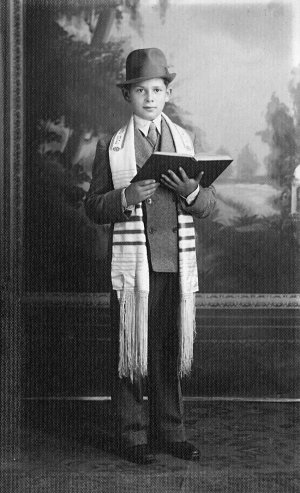 The main thing I notice about this exhibit is that it is totally, 100% about Jews and specifically Jewish concerns. The few non-Jews mentioned are enemies of the Jews. While it starts out saying that by the 1930’s Jews were increasingly comfortable with American ways, it shows nothing about Jews integrating socially with American gentiles and Christians, but only sticking closely with their own kind, their own organizations, their synagogues and businesses. Jews want to be accepted by the majority Gentile culture as “just like them,” but they do not want to participate in the majority Gentile culture, except politically and financially. [Left: Bar Mitzveh Day for Harry Klein]
The main thing I notice about this exhibit is that it is totally, 100% about Jews and specifically Jewish concerns. The few non-Jews mentioned are enemies of the Jews. While it starts out saying that by the 1930’s Jews were increasingly comfortable with American ways, it shows nothing about Jews integrating socially with American gentiles and Christians, but only sticking closely with their own kind, their own organizations, their synagogues and businesses. Jews want to be accepted by the majority Gentile culture as “just like them,” but they do not want to participate in the majority Gentile culture, except politically and financially. [Left: Bar Mitzveh Day for Harry Klein]
It tells us that Michigan Jews were terribly affected by the war in Europe—the spread of Nazism in Europe brought rising “anti-Semitism” in the U.S, and Michigan was not spared! Evil people like Catholic priest Father Charles Coughlin were openly “anti-Semitic” and 30 million non-Jewish Americans listened to his weekly radio broadcasts. [Shown at right speaking over WJR radio in the 1930s] The exhibit particularly excoriates Father Coughlin simply because he warned about excessive power of the Jews. The exhibit shows that Life and Time magazines, and the powerful Detroit Free Press were all on the side of the Jews against Father Coughlin … so where was the problem? Are we dealing with a real threat or with some kind of Jewish agenda here?
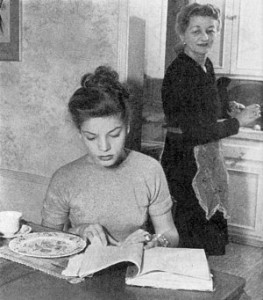
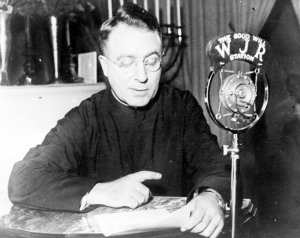
At the same time, Jews like Lauren Bacall [at left as a young woman at home – look at the nose on Mom! Was Lauren given a nose job?] and baseball player Hank Greenberg were given great, positive media attention.
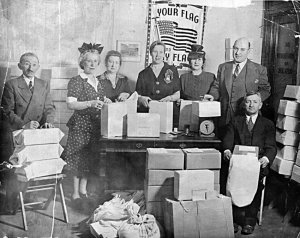 The exhibit tells how the Jews of Michigan supported the war. America’s participation was a wonderful thing. Helping the European Jews was what we should all be doing. Jews like young Harriet Fields collected 381,000 pounds of household waste fat! The Federation of Polish Jews in Detroit [shown right, publicizing their war service] sent packages to the men and women of the Armed Services. The Jewish-owned Paramount Coffee Company of Lansing sent out New Year’s Greeting flyers about the importance of helping one another (without mentioning the war at all, though). The Temple Beth El Bulletin encouraged people to buy war bonds!
The exhibit tells how the Jews of Michigan supported the war. America’s participation was a wonderful thing. Helping the European Jews was what we should all be doing. Jews like young Harriet Fields collected 381,000 pounds of household waste fat! The Federation of Polish Jews in Detroit [shown right, publicizing their war service] sent packages to the men and women of the Armed Services. The Jewish-owned Paramount Coffee Company of Lansing sent out New Year’s Greeting flyers about the importance of helping one another (without mentioning the war at all, though). The Temple Beth El Bulletin encouraged people to buy war bonds!
Jewish organizations made sure they offered social and spiritual support for specifically Jewish soldiers. Beginning in 1942, Jews began protesting a “Nazi Holocaust” of European Jews in Detroit newspapers and in public meetings. The exhibit shows pictures of two whole Michigan Jews who had fallen … they are portrayed as heroes. And it doesn’t leave out that America did not want to take in all of Europe’s Jewish refugees who wanted to come here. It points out everything that the Jews did to help other Jews, and how they got non-Jews to help Jews too.
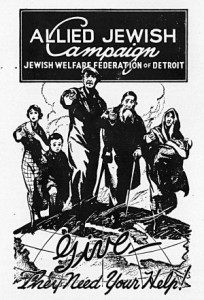 The Allied Jewish Campaign raised money to help Jews. Wow, what sacrifice! “Between 1932 and 1940, its theme shifted from taking care of the needy Jews in the United States to supporting rescue and survival of Jews abroad.” It’s fundraising goal rose from $165,000 to $925,000. Guess who they got most of the money from?
The Allied Jewish Campaign raised money to help Jews. Wow, what sacrifice! “Between 1932 and 1940, its theme shifted from taking care of the needy Jews in the United States to supporting rescue and survival of Jews abroad.” It’s fundraising goal rose from $165,000 to $925,000. Guess who they got most of the money from?
And, of course, “Michigan Jews, especially in Detroit, were active on behalf of building a Jewish homeland in Palestine.” Finally, the stories of four Jewish children who came to the U.S as refugees and are such treasures. Then, MSU’s Jeanette Abeles , Ken Waltzer and Michael Seadle tell stories, with pictures, of their Jewish family history, though none were connected with Michigan. Have we heard enough about Jews yet?
From whence the money comes
This traveling exhibition was made possible with financial support from Congregation Shaarey Zedek of East Lansing, Michigan State University Jewish Studies Program (that’s Waltzer’s domain), Michigan State University Museum, the Michigan Humanities Council, the Ben Teitle Foundation, the Michigan Council for Arts and Cultural Affairs and private donors.
For a fee of $800, plus shipping, the exhibition has been displayed at the following sites so far (according to the website): Northern Michigan University, Marquette, MI; Macomb Community College, Clinton Twp, MI; and Kalamazoo Valley Museum, Kalamazoo, MI.
This “anti-anti-Semitism” project extolling the virtues of Jews is what Ken Waltzer has kept himself busy with in 2013, instead of finishing his book on the children of Buchenwald. What will he come up with next? It’s been clear for some time that the main guiding force for Waltzer is the promotion of Jewry, in whatever way best achieves that goal. Holocaustianity is certainly one way. Heading a Jewish Studies program at a university is another. Working in conjunction with the U.S. Holocaust Memorial Museum is another. And certainly, protecting and promoting the image of Elie Wiesel is also one.
It’s possible, however, that he’s run into a brick wall on Elie Wiesel.
Endnotes:
1. Waltzer admittedly relies on survivor testimony – the least dependable form of “evidence.” In this 2011-2012 Q-A session linked to above, he says:
… my own book, Telling the Story: The Rescue of Children at Buchenwald, will be finished in about a year and will tell the story in much greater detail and more attention to complexity, drawing on information obtained from nearly 200 of those who were helped to survive at the Nazi camp. It will say more about who these boys were, what their experiences were both before Buchenwald and then inside Buchenwald, and where they went and what they did with their memory of experience after liberation. A second book, to be prepared thereafter, will be called Children’s Stories, and will pull together many distinctive stories I’ve been told or have encountered while working on the collective story.
Note that Waltzer is “telling a story” that has been told to him by old men about what happened to them as children. Realize what “story” means to Jews – one is freed from all necessity of accurate fact.
8 Comments
Category Featured | Tags: Tags: Allied Jewish Campaign, anti-Semitism, Charles Coughlin, Hank Greenberg, Jeanette Abeles, Jewish homeland in Palestine, Ken Waltzer, Lauren Bacall, Michael Seadle, Michigan State University,
Social Networks: Facebook, Twitter, Google Bookmarks, del.icio.us, StumbleUpon, Digg, Reddit, Posterous.












